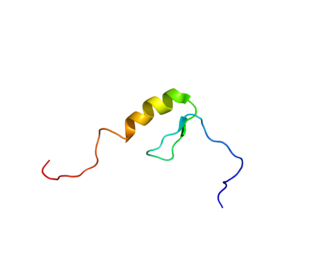FEZ family zinc finger 1 is a protein that in humans is encoded by the FEZF1 gene. [5]
FEZ family zinc finger 1 is a protein that in humans is encoded by the FEZF1 gene. [5]
FEZF1 is a gene that encodes for transcriptional repressors, and it has been shown to repress the transcription factor HES5. [6] In the mouse, FEZF1 is expressed in the forebrain in early development of the embryo. This suppression of HES5 helps to control the differentiation of neural stem cells. [6] FEZF1 also helps to divide the caudal forebrain into three distinct parts during development: the prethalamus, the thalamus, and the pretectum. Mice lacking FEZF1 had no prethalamus and had a smaller thalamus. [7] A loss of function mutation in FEZF1 causes Kallmann Syndrome. [8] As axons are developing and migrating in the early embryo, FEZF1 allows the axons of olfactory neurons to attach to the central nervous system in the mice model. During neural development, GnRH neurons migrate through one of these olfactory axon pathways, and the loss of function of FEZF1 therefore results in the loss of GnRH neurons in the brain, the hallmark of Kallmann Syndrome. [8]

The thalamus is a large mass of gray matter located in the dorsal part of the diencephalon. Nerve fibers project out of the thalamus to the cerebral cortex in all directions, allowing hub-like exchanges of information. It has several functions, such as the relaying of sensory signals, including motor signals to the cerebral cortex and the regulation of consciousness, sleep, and alertness.

RE1-Silencing Transcription factor (REST), also known as Neuron-Restrictive Silencer Factor (NRSF), is a protein which in humans is encoded by the REST gene, and acts as a transcriptional repressor. REST is expressly involved in the repression of neural genes in non-neuronal cells. Many genetic disorders have been tied to alterations in the REST expression pattern, including colon and small-cell lung carcinomas found with truncated versions of REST. In addition to these cancers, defects in REST have also been attributed a role in Huntington Disease, neuroblastomas, and the effects of epileptic seizures and ischemia.

Zinc finger protein 148 is a protein that in humans is encoded by the ZNF148 gene.

Zinc finger protein 350 is a protein that in humans is encoded by the ZNF350 gene.

Zinc finger protein OZF is a protein that in humans is encoded by the ZNF146 gene.

Zinc finger protein 217, also known as ZNF217, is a protein which in humans is encoded by the ZNF217 gene.

Zinc finger protein 74 is a protein that in humans is encoded by the ZNF74 gene. Schizophrenia susceptibility has been associated with a mutation in this protein.

Zinc finger protein 202 is a transcription factor first associated with breast cancer. It is a protein that, in humans, is encoded by the ZNF202 gene.

Zinc finger protein 238 is a zinc finger containing transcription factor that in humans is encoded by the ZNF238 gene.

Zinc finger protein 10 is a protein that in humans is encoded by the ZNF10 gene.

Zinc finger and BTB domain-containing protein 32 is a protein that in humans is encoded by the 1960 bp ZBTB32 gene. The 52 kDa protein is a transcriptional repressor and the gene is expressed in T and B cells upon activation, but also significantly in testis cells. It is a member of the Poxviruses and Zinc-finger (POZ) and Krüppel (POK) family of proteins, and was identified in multiple screens involving either immune cell tumorigenesis or immune cell development.

Zinc finger protein 219 is a protein that in humans is encoded by the ZNF219 gene.

Zinc finger protein 366, also known as DC-SCRIPT, is a protein that in humans is encoded by the ZNF366 gene. The ZNF366 gene was first identified in a DNA comparison study between 85 kb of Fugu rubripes sequence containing 17 genes with its homologous loci in the human draft genome.

Zinc finger protein 41 is a protein that in humans is encoded by the ZNF41 gene.

Zinc finger protein 268 is a protein that in humans is encoded by the ZNF268 gene.

Zinc finger protein 423 is a protein that in humans is encoded by the ZNF423 gene.

Zinc finger protein 224 is a protein that in humans is encoded by the ZNF224 gene.

T-box, brain, 1 is a transcription factor protein important in vertebrate embryo development. It is encoded by the TBR1 gene. This gene is also known by several other names: T-Brain 1, TBR-1, TES-56, and MGC141978. TBR1 is a member of the TBR1 subfamily of T-box family transcription factors, which share a common DNA-binding domain. Other members of the TBR1 subfamily include EOMES and TBX21. TBR1 is involved in the differentiation and migration of neurons and is required for normal brain development. TBR1 interacts with various genes and proteins in order to regulate cortical development, specifically within layer VI of the developing six-layered human cortex. Studies show that TBR1 may play a role in major neurological diseases such as Alzheimer's disease (AD), Parkinson's disease (PD) and autism spectrum disorder (ASD).

Zinc finger protein 536 is a protein that in humans is encoded by the ZNF536 gene.

Zinc Finger Protein 548 (ZNF548) is a human protein encoded by the ZNF548 gene which is located on chromosome 19. It is found in the nucleus and is hypothesized to play a role in the regulation of transcription by RNA Polymerase II. It belongs to the Krüppel C2H2-type zinc-finger protein family as it contains many zinc-finger repeats.